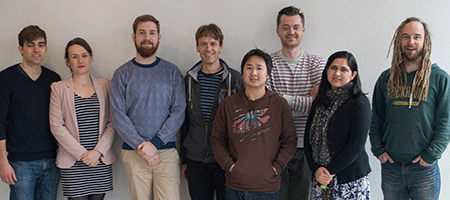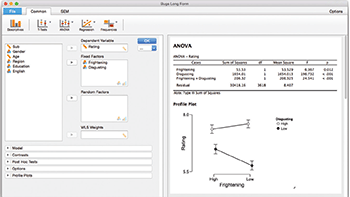Software to Sharpen Your Stats

Current members of the JASP team, Amsterdam division, are, from left to right, Quentin Gronau, Dora Matzke, Ravi Selker, Eric-Jan Wagenmakers, Alexander Ly, Maarten Marsman, Tahira Jamil, and Jonathon Love.
The last few decades have witnessed the growth of SPSS as the statistical software of choice across a wide range of academic disciplines. Its pedigree reaches back as far as the 1960s, when SPSS was first programmed with punch cards. As computing advanced, SPSS continued to keep pace; next, it became available for mainframe environments, and then, with the rise of the “personal computer,” SPSS became available for command-based DOS environments. Finally, with the ascent of Microsoft Windows and other graphical operating systems, SPSS became equipped with a graphical user interface. Over the years, this ability to adapt and change has allowed SPSS to remain relevant and helpful for both teaching and research.
More recently, however, SPSS has not been as actively developed as it once was. Although statisticians have proposed many useful analyses in the last few years, many of these proposals remain unavailable in SPSS. Similarly, SPSS has not kept pace with trends toward ease and simplicity in user-interface design. The SPSS menu system remains deep and complex, analysis options are not always intuitively labeled, and SPSS often produces substantial output, requiring users to engage in a quest to find the values of interest.
These emerging issues are unfortunate for the SPSS user base, but at the same time they create an opportunity for the scientific community to produce a compelling alternative. With a European Research Council grant, our project “Bayes or Bust: Sensible Hypothesis Tests for Social Scientists” has allowed us to develop JASP, a free and open statistical software package designed to be familiar to users of SPSS. JASP distinguishes itself from SPSS by being as simple, intuitive, and approachable as possible, and by making accessible some of the latest developments in Bayesian analyses. At time of writing, JASP version 0.6 implements the following analysis tools in both their classical and Bayesian manifestations:
- Descriptive statistics
- t tests
- Independent samples ANOVA
- Repeated measures ANOVA
- Correlation
- Linear regression
- Contingency tables
This set of analysis tools provides a solid base for most students and researchers. Additional analyses are continually added to JASP, such that it will quickly become a comprehensive alternative to SPSS.

Figure 1. JASP screenshot of an ANOVA performed on a subset of “bugs” data from Ryan, Wilde, and Crist (2013) concerning repulsiveness ratings for sets of frightening and/or disgusting insects.
JASP maintains a minimalist design philosophy. In JASP, analyses are clearly labeled; for instance, the ANOVA is available through a menu item called “ANOVA.” And results are user-friendly: a minimalist, attractive ANOVA table, already in APA format and waiting to be copied and pasted into Word (see Figure 1 for an example).
This simplicity reflects the design philosophy that good software gets out of the users’ way, letting them focus on what they want to achieve without first having to “learn the software.” Far from dumbing down statistics through “point-and-click,” we believe that JASP allows students and researchers to pay attention to what matters: not the software, but the analyses and the results.
As mentioned, JASP implements a number of Bayesian analyses, making heavy use of Morey and Rouder’s (2015) BayesFactor R package, which implements a range of Bayesian hypothesis tests. Compared with classical hypothesis tests that produce p values, Bayesian hypothesis tests have a number of distinct practical advantages. Most notably, Bayesian hypothesis tests can quantify evidence in favor of the null hypothesis, and they allow users to monitor evidence continually, as the data accumulate.
Another advantage of JASP for students and universities is that it comes free of charge. In contrast, campus licenses for SPSS can cost upwards of €30,000 per year. This leads us to estimate that SPSS costs the scientific and university communities in the order of $50 million each year. Consistent with this estimate, SPSS was purchased by IBM in 2009 for $1.2 billion. Over time, the recurring annual licensing fees sum to a truly staggering amount of money; one can only dream of the alternative projects and educational initiatives that this money could support.
But arguably more important than being free, JASP is open source. That is, the source code, the underlying algorithms that determine its behavior, are publicly available with permission for people to use as they see fit. Anyone can take the code, inspect it, modify it, and build on it. Software that is not open source prevents others from building on that work and leaves users at the mercy of the owner. In contrast, JASP will always be available to the scientific community to adapt to their needs.
The fact that JASP is open source brings another advantage: community. Due to the open nature of development, open-source projects such as JASP can create a community around them and take advantage of work produced by other open-source software communities. An example of this is JASP’s use of the R programming language “under the hood,” with many analyses in JASP provided through open-source R packages. Similarly, development is underway to allow people to develop and publish their own analyses in JASP.
Given the ambition and promise of JASP, a question remains: When will JASP be ready? This is a difficult question with two answers: now and never. In a sense, JASP development will always be ongoing; there are always new features that can be added to software, and there are always additional analyses that can be incorporated, possibly through separate JASP modules. So, in that sense, JASP will never be “ready.” But then, for many researchers and institutions, JASP provides many standard analyses, and it is already a useful tool for both teaching and research. Anyone can evaluate for themselves whether and when JASP will meet their needs.
Despite its advantages over SPSS, at the time of publication, JASP has a number of substantial omissions. At present, there are no facilities for editing, cleaning, or restructuring data. Similarly, it is possible only to export the results from analyses, and at present there is no facility for saving and reopening analyses performed earlier. Moreover, some important analysis methods are missing, there is no help functionality, and graphical output is limited. These omissions will be addressed in the coming months.
We encourage people to begin exploring and evaluating JASP today. It is simple and minimalist. Additionally, given the growing importance of Bayesian statistics in psychology, it is a “future-proof” solution. Using JASP, the transition to Bayesian statistics will be straightforward and relatively painless.
For those who wish to learn more about JASP and Bayesian statistics in JASP, a number of workshops are available in the upcoming months, all listed on the JASP website. The first workshop, “Bayesian Hypothesis Testing Using JASP,” will be held March 13 at the International Convention of Psychological Science in Amsterdam.
JASP is available for Windows, Mac OS X, and Linux.
Jeffrey N. Rouder and Richard D. Morey will speak at the 2015 APS Annual Convention in New York City, May 21–24.
References and Further Reading
Morey, R. D., & Rouder, J. N. (2015). BayesFactor: Computation of Bayes factors for common designs. R package version 0.9.10-1. Retrieved from http://CRAN.R-project.org/package=BayesFactor
Rouder, J. N. (2014). Optional stopping: No problem for Bayesians. Psychonomic Bulletin & Review, 21, 301–308.
Ryan, R. S., Wilde, M., & Crist, S. (2013). Compared to a small, supervised lab experiment, a large, unsupervised Web-based experiment on a previously unknown effect has benefits that outweigh its potential costs. Computers in Human Behavior, 29, 1295–1301.
Wagenmakers, E. J. (2007). A practical solution to the pervasive problem of p values. Psychonomic Bulletin and Review, 14, 779–804.





Comments
Exciting.
Looking forward to exploration at the current state of development.
Thanks to the Observer for this link.
APS regularly opens certain online articles for discussion on our website. Effective February 2021, you must be a logged-in APS member to post comments. By posting a comment, you agree to our Community Guidelines and the display of your profile information, including your name and affiliation. Any opinions, findings, conclusions, or recommendations present in article comments are those of the writers and do not necessarily reflect the views of APS or the article’s author. For more information, please see our Community Guidelines.
Please login with your APS account to comment.